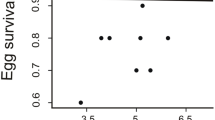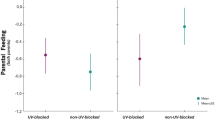Abstract
While elaborate carotenoid-based traits in adult birds may have evolved as honest signals of individual quality in the context of sexual selection or other social interactions, the function of carotenoid-based colours in juveniles is less well understood. We investigated the hypothesis that carotenoid-based nestling colouration has evolved in response to parental preference of intensely coloured offspring during food provisioning. In a field experiment, we manipulated nestling plumage colouration by a carotenoid-supplementation and analysed the parental food provisioning behaviour before feather appearance and at the end of the nestling stage. Carotenoids per se did not influence the nestling’s begging behaviour or parental feeding decisions and we found no evidence that carotenoid-based colouration in nestling great tits has a signalling function in parent-offspring interactions. Parents did not discriminate between intensely coloured and control offspring in their food provisioning and in accordance with this finding intensely coloured nestlings were not heavier or larger at the end of the nestling stage. Alternative explanations for the evolution of carotenoid-based colours in nestling birds are discussed.


Similar content being viewed by others
References
Andersson (1994) Sexual selection. Princeton University Press, Princeton
Baker RR, Parker GA (1979) The evolution of bird coloration. Philos Trans R Soc Lond B 287:63–130
Bendich A (1989) Carotenoids and the immune response. J Nutr 119:112–115
Booth CL (1990) Evolutionary significance of ontogenetic colour change in animals. Biol J Linn Soc 40:25–163
Brush AH (1978) Avian pigmentation. In: Brush AH (ed) Chemical zoology, vol X. Aves. Academic, New York, pp 141–164
Butcher GS, Rohwer S (1989) The evolution of conspicuous and distinctive coloration for communication in birds. Plenum Press, London
Chew BP, Park JS (2004) Carotenoid action on the immune response. J Nutr 134:257S–261S
Christe P, Richner H, Oppliger A (1996) Of great tits and fleas: sleep baby sleep. Anim Behav 52:1087–7092
Cohen J (1988) Statistical power analysis for the behavioural sciences, 2nd edn. Lawrence Erlbaum, Hillsdale
Edge R, McGarvey DJ, Truscott TG (1997) The carotenoids as anti-oxidants: a review. J Photochem Photobiol B 41:189–200
Endler JA (1990) On the measurement and classification of colour in studies of animal colour patterns. Biol J Linn Soc 41:315–352
Ficken MS (1965) Mouth colour of nestling passerines and its use in taxonomy. Wil Bull 77:71–75
Fitze PS, Richner H (2002) Differential effects of a parasite on ornamental structures based on melanins and carotenoids. Behav Ecol 13:401–407
Fitze PS, Kölliker M, Richner H (2003) Effects of common origin and common environment on nestling plumage coloration in the great tit (Parus major). Evolution 57:144–150
Gosler A (1993) The great tit. Hamlyn, London
Götmark F, Ahlström M (1997) Parental preference of red mouth of chicks in a songbird. Proc R Soc Lond B 264:959–962
Götmark F, Olsson J (1997) Artificial colour mutation: do red-painted great tits experience increased or decreased predation?. Anim Behav 53:83–91
Hill GE (1999) Mate choice, male quality, and carotenoid-based plumage coloration. Proc Int Ornithol Congr 22:1654–1668
Hill GE (2000) Energetic constraints on expression of carotenoid-based plumage coloration. J Avian Biol 31:559–566
Hill GE, Montgomerie R (1994) Plumage color signals nutritional condition in the house finch. Proc R Soc Lond B 258:47–52
Hunt S, Kilner RM, Langmore NE, Bennett ATD (2003) Conspicuous, ultraviolet-rich mouth colours in begging chicks. Proc R Soc Lond B 270:S25–S28
Jenni L, Winkler R (1994) Moult and aging of European passerines. Academic, London
Johnsen A, Delhey K, Andersson S, Kempenaers B (2003) Plumage colour in nestling blue tits: sexual dichromatism, condition dependence and genetic effects. Proc R Soc Lond B 270:1263–1270
Kilner R, Davies NB (1998) Nestling mouth colour: ecological correlates of a begging signal. Anim Behav 56:705–712
Kölliker M, Richner H, Werner I, Heeb P (1998) Begging signals and biparental care: nestling choice between parental feeding locations. Anim Behav 55:215–222
Lyon BE, Eadie JM, Hamilton LD (1994) Parental choice selects for ornamental plumage in coot chicks. Nature 371:240–243
McGraw KJ, Hill GE (2000) Carotenoid-based ornamentation and status signalling in the house finch. Behav Ecol 11:520–527
Olson VA, Owens IPF (1998) Costly sexual signals: are carotenoids rare, risky or required? Trends Evol Ecol 13:510–514
Partali V, Liaaen-Jensen S, Slagsvold T, Lifjeld JT (1987) Carotenoids in food chain studies: II. The food chain of Parus spp. monitored by carotenoid analysis. Comp Biochem Physiol B 87(4):885–888
Pryke SR, Lawes MJ, Andersson S (2001) Agonistic carotenoid signalling in male red-collared widowbirds: aggression related to the colour signal of both the territory owner and model intruder. Anim Behav 62:695–704
Rohwer S (1975) The social significance of avian winter plumage variability. Evolution 29:593–610
Ryan MJ (1998) Sexual selection, receiver biases, and the evolution of sex differences. Science 281:1999–2003
Saino N, Ninni P, Calza S, Martinelli R, De Bernardi F, Møller AP (2000) Better red than dead: carotenoid-based mouth coloration reveals infection in barn swallow nestlings. Proc R Soc Lond B 267:57–61
Sall J, Lehmann A (1996) JMP start statistics. Duxbury Press, New York
Senar JC (1999) Plumage colouration as a signal of social status. Proc Int Ornithol Congr 22:1669–1686
Slagsvold T, Lifjeld JT (1985) Variation in plumage colour of the great tit Parus major in relation to habitat, season and food. J Zool 206:321–328
Tschirren B, Fitze PS, Richner H (2003) Proximate mechanisms of variation in the carotenoid-based plumage coloration of nestling great tits (Parus major L). J Evol Biol 16:91–100
Wolfenbarger LL (1999) Is red coloration of male Northern Cardinals beneficial during the nonbreeding season?: a test of status signaling. Condor 101:655–663
Acknowledgements
We thank Hoffmann, La Roche, Basel for kindly providing carotenoids (Lutein 5%-beadlets) and placebos, Jean-Daniel Charrière and Peter Fluri for providing bee larvae, Kurt Bernhard for his helpful advise, the participants of the Colour Signalling Meeting 2004 at Konnevesi Research Station, Finland for discussion and Heli Siitari and Sveinn Are Hanssen for their helpful comments on the manuscript. The experiment was financially supported by the Swiss National Science Foundation and conducted under a licence provided by the Office of Agriculture of the Canton of Bern, Switzerland.
Author information
Authors and Affiliations
Corresponding author
Rights and permissions
About this article
Cite this article
Tschirren, B., Fitze, P.S. & Richner, H. Carotenoid-based nestling colouration and parental favouritism in the great tit. Oecologia 143, 477–482 (2005). https://doi.org/10.1007/s00442-004-1812-z
Received:
Accepted:
Published:
Issue Date:
DOI: https://doi.org/10.1007/s00442-004-1812-z




